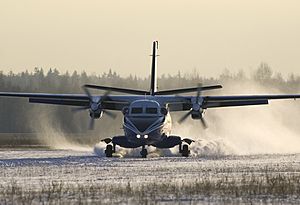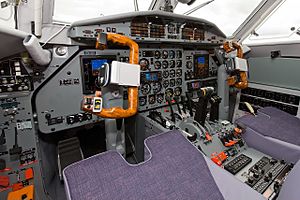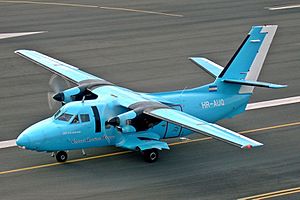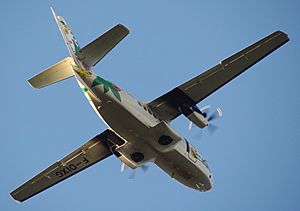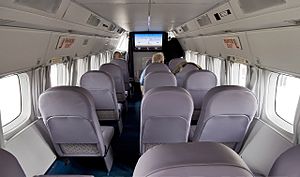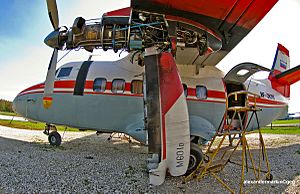Let L-410 Turbolet facts for kids
Quick facts for kids L-410 Turbolet |
|
|---|---|
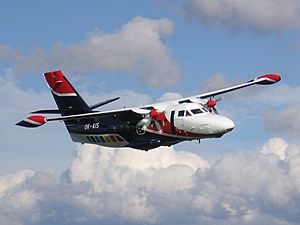 |
|
| Role | Regional airliner, cargo aircraft |
| Manufacturer | Let Kunovice |
| First flight | 16 April 1969 |
| Introduction | 1970 |
| Status | In service |
| Produced | 1971–present |
| Number built | 1,200 |
| Variants | Aircraft Industries L 410 NG |
The Let L-410 Turbolet is a special airplane with two engines. It was designed and built in the Czech Republic by a company called Let Kunovice. This aircraft is made for short flights and can carry people or cargo.
It was first designed in the 1960s because a big airline, Aeroflot, needed a new plane. The very first flight of the L-410 was on April 16, 1969. Since 1970, many airlines and even military groups have used the L-410. It's great because it can land on short runways, even ones that aren't paved. It can also fly in very hot or very cold weather, from -50°C to +50°C!
Over 50 years, many different versions of the L-410 have been made. At first, some planes used engines from Canada, but most later models used engines made in the Czech Republic. The planes have changed in size and what they can do. In the 1990s, the company started selling the plane to countries in the West. They got special approvals from important aviation groups like the Federal Aviation Administration (FAA) in the USA and the European Union Aviation Safety Agency (EASA).
One of the newest and best versions is the Aircraft Industries L 410 NG. This plane can fly twice as far as the original! It also has a modern "glass cockpit" with digital screens. By 2016, more than 1,200 L-410 planes had been built. Over 350 of them were still flying in more than 50 countries around the world.
Contents
How the L-410 Turbolet Was Developed
The L-410 was first designed in the mid-1960s by the Czechoslovak company Let Kunovice. The company saw a chance to build a new plane for the Soviet airline Aeroflot. Aeroflot needed a new plane to replace their older Antonov An-2 biplane. The new plane would use turboprop engines. Let Kunovice thought this would be a great opportunity. They first worked on a design called the L-400. They planned for it to carry both passengers and cargo.
After many changes, the company created a new design called the L-410 Turbolet. The very first test flight of the XL-410 prototype was on April 16, 1969. Two pilots, Vladimir Vik and Frantisek Svinka, flew it. This prototype plane was used for testing and also to show off the aircraft to possible buyers. It even appeared at the 1969 Paris Air Show. At first, the Czech engines weren't ready. So, the first planes used engines and propellers from North America.
Later, a Czech engine called the M601 was ready. This engine was used in the second version of the plane, called the L-410M. Another version, the L-410 UVP, was made especially for Aeroflot. They wanted a plane that could take off and land better. This new version had bigger wings and tail. This made it a Short Take-off/Landing (STOL) aircraft. This means it can use shorter runways. Because it was a bit heavier, the L-410 UVP carried 15 passengers instead of more.
The most common version is the L-410 UVP-E. This plane can take off with more weight. It has stronger M601E engines and new five-blade propellers. It can also have extra fuel tanks on its wing tips to fly further. The L-410 UVP-E first flew in 1984. Many of these planes were built starting in 1986. By 1990, over 1,000 L-410s had been made.
The L-410 UVP-E9 and L-410 UVP-E20 are very similar versions. They were made to meet different rules in various countries. Some later L-420 planes used an even newer M601F engine. In the early 2000s, the L-410 UVP-E20 was still being built. It used the latest M601 engine, called the GE H80-200, and new five-blade propellers.
After the Cold War ended, the company wanted to sell the plane in Western countries. The L-410 was approved for use in North America by the Federal Aviation Administration (FAA) in 1998. The improved L-410 UVP-E20 was approved by the FAA in 2015. This same model was also approved by the European Union Aviation Safety Agency (EASA) in 2005. Other versions were approved later. In the mid-2010s, about 15 L-410 UVPs were built each year.
In 2013, a Russian company became the main owner of Let Kunovice. They planned to start building the L-410 in Russia too. As part of this plan, they created the biggest version yet, the Aircraft Industries L 410 NG. You can tell it apart by its longer nose and bigger back area. This bigger back area means it can carry twice as much luggage! It also has new wings and a modern Garmin G3000 glass cockpit. The engines are more powerful and quieter GE H85 engines. The L 410 NG can fly twice as far as the original L-410.
The first L 410 NG made in Russia was shown on September 3, 2013. It flew for the first time on July 29, 2015. Its engines became more powerful, and its speed increased. The maximum weight it could take off with also increased. Its flying range grew from 820 nautical miles to 1,350 nautical miles. The fuel capacity also increased a lot, and it could fly for nine hours instead of five. It received important approvals in late 2017. Building of the L 410 NG started in March 2018.
Design of the L-410 Turbolet
The Let L-410 Turbolet is an all-metal airplane with high wings. It does not have a pressurized cabin. It is known for being easy to maintain and not too expensive to fly. It can also be changed easily for different uses. All models have landing gear that can be pulled up into the plane.
The L-410 UVP-E has two hydraulic systems for its controls. One is the main system, and the other is for emergencies. The main electrical system uses 28V DC power. It also has a system to prevent ice from building up on the wings and propellers. The maximum take-off weight for the L-410 UVP-E is 6,400 kg. The E9 and E20 versions can carry up to 17 to 19 passengers. The L-410 UVP-E uses Avia V 510 five-blade propellers.
The L 410 UVP-E20 has been approved to fly in many countries. This includes countries in Europe, the United States, Brazil, India, Australia, and many others. The plane is approved for flying using instruments in bad weather. It can also land using a special system called ILS and fly in icy conditions.
Different Versions of the L-410
Here are some of the different versions of the L-410:
- L-410: This was the very first test model. Only three were built.
- L-410A: The first planes made for sale. They used Pratt & Whitney engines. Twelve were built.
- L-410AB: A version with four-bladed propellers.
- L-410AF: Used for taking aerial photos. It was sent to Hungary.
- L-410AS: Test planes sent to the USSR. Five were built.
- L-410FG: Another version for aerial photography, based on the L-410UVP.
- L-410M: The second series, using Walter M601A engines.
- L-410AM: An improved version with M601B engines.
- L-410 UVP: This was a greatly changed third series. It had a longer body and wider wings. It also used M601B engines. This version is known for its STOL (short take-off and landing) abilities.
- L-410 UVP-S: A special passenger version of the UVP.
- L-410 UVP-E: This version had stronger M601E engines and five-bladed Avia V510 propellers. It could also have extra fuel tanks.
- L-410T: A transport version of the UVP. It had a larger loading door. It could carry 6 stretchers for medical use or 12 parachutists. It could also carry 1,000 kg of cargo.
- L-420: An upgraded L-410 UVP-E with new M601F engines.
- L 410 NG: A much redesigned and larger version. It has new GE H85 engines and a modern glass cockpit. It can carry twice as much cargo and fly for about twice as long.
Who Uses the L-410 Turbolet
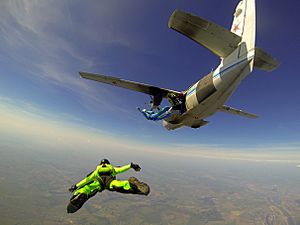
Many L-410 planes were sent to the former Soviet Union. By 1985, 500 planes were being used there. Because of this, many countries that used to be part of the Soviet Union, especially Russia, still use the L-410 a lot. Also, many L-410s have been sold to airlines in Asia, Africa, Central America, and South America. About 40 planes are used in Europe for commercial flights, including for skydivers.
Civilian Operators
In July 2015, 178 Let L-410 planes were being used by airlines. Most were in Africa (73) and Europe (58). Some were in the Americas (41) and Asia Pacific/Middle East (6). Airlines that had four or more L-410s included:
- 25: Air-Tec Global
- 8: Orenburzhie Air Company
- 7: Searca
- 5: Kin Avia and Petropavlovsk-Kamchatsky Air Enterprise
- 4: Air Express Algeria, Eagle Air, Solenta Aviation, 2nd Arkhangelsk United Aviation Division, Van Air Europe, Komiaviatrans, KrasAvia, Air Guyane Express and Comeravia
Accidents and Safety
The L-410 has been involved in some accidents. It's important to know that the way a plane is flown and maintained can affect its safety. The design of the L-410 itself might not be the main reason for these events.
L-410 UVP-E20 Specifications
Here are some facts about the L-410 UVP-E20 model:
- Crew: 2 pilots
- Capacity: 19 passengers or 1,800 kg of cargo
- Length: 14.42 meters
- Wingspan: 19.98 meters
- Height: 5.97 meters
- Wing area: 34.86 square meters
- Empty weight: 4,200 kg
- Maximum take-off weight: 6,600 kg
- Fuel capacity: 1,300 kg
- Engines: 2 General Electric H80-200 turboprop engines, each with 597 kW of power.
- Propellers: 5-bladed Avia AV 725 propellers, 2.3 meters wide.
- Cruise speed: 405 km/h (maximum cruise speed)
- Range: 1,500 km (with 1,800 kg cargo, at 4,267 meters altitude)
- Endurance: Five hours and six minutes
- Ceiling: 8,382 meters (how high it can fly)
- Climb rate: 8.5 meters per second
- Fuel consumption: 240 kg per hour
- Take-off run: 510 meters (how much runway it needs to take off)
- Landing run: 500 meters (how much runway it needs to land)
See also
 In Spanish: Let L-410 Turbolet para niños
In Spanish: Let L-410 Turbolet para niños
- Aircraft related to this one
- Aircraft Industries L 410 NG
- Similar aircraft
- Antonov An-28/PZL M28 Skytruck
- Beriev Be-30
- Britten-Norman Trislander
- CASA C-212 Aviocar
- de Havilland Canada DHC-6 Twin Otter
- Dornier 228
- Embraer EMB 110 Bandeirante
- Harbin Y-12
- IAI Arava
- Short SC.7 Skyvan


